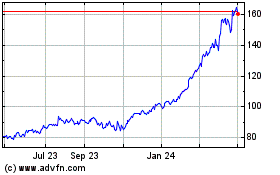GE Shed About 78,000 Workers in 2019 -- Update
February 24 2020 - 7:25PM
Dow Jones News
By Thomas Gryta
General Electric Co. last year shed roughly 78,000 employees, or
more than a quarter of its workforce, as divestitures left the
company with the same number of employees as it had in 1951.
The company ended 2019 with about 205,000 global workers, down
from about 283,000 a year ago, according to GE's annual report
filed on Monday. In the U.S., its workforce dropped to 70,000.
It is the lowest number of employees at GE since the post World
War II boom. The company ended 1951 with an average workforce of
about 210,000 and had more than 400,000 by 1969, according to a
review of the company's annual reports.
The 2019 reduction is almost entirely explained by GE's decision
to part with two units: the oil and gas division and the
transportation business. The oil business had more than 65,000
employees, while the transportation unit had more than 9,000.
GE sold its oil and gas business to Baker Hughes Co. in 2017 but
kept a majority stake until last year. After reducing its stake in
2019, GE no longer controls the company or counts Baker Hughes's
financial results or staff as its own. The transportation business
was merged with Wabtec Corp. in early 2019, transferring those
workers.
"Our work is by no means finished, but we are on the right
path," GE Chairman and Chief Executive Larry Culp wrote in his
second annual letter to shareholders. Mr. Culp, the first outsider
to run GE, was appointed to the top job in October 2018 when
problems in a legacy insurance unit and its power division prompted
the company to slash its dividend and profit targets.
GE, which once operated facilities in all 50 states and dozens
of countries around the world, also scaled back its global
footprint by selling those divisions and restructuring its
operations. In the past year, GE reduced its footprint by 175
manufacturing facilities world-wide. Its U.S. plants dropped to 94
sites from 162 reported a year ago.
GE's biggest unit, in terms of employees, is now its health-care
business, which employed 56,000 people at the end of 2019. An
additional 52,000 work at its aviation division. About 43,000 are
in its renewable energy unit, after GE shifted some operations from
the struggling power unit, which now employs 38,000 around the
world.
There are about 2,000 people at GE Capital, a lending arm that
has been shrinking. The remaining employees, roughly 13,000, are
housed in GE's corporate operation, which also includes its retail
lighting business, its digital operations, a global sales group and
its research work.
GE's size is likely to shrink further as it awaits final
approval for the $21 billion sale of its biopharma business to
Danaher Corp. The deal, reached a year ago, is awaiting regulatory
review. GE says it expects the deal to close in the current
quarter.
In his letter, Mr. Culp reiterated his strategy of paying down
the company's debt levels and improving its operations. GE last
year reduced its total borrowings by more than $10 billion to $90.9
billion, including its GE Capital arm.
Last week, Mr. Culp cautioned investors the grounding of the
Boeing Co. 737 MAX aircraft would pressure GE's ability to generate
cash in the first half of the year, but he stood by his targets for
the full year. He has forecast $2 billion to $4 billion in positive
cash flow for the year from the industrial business.
Shares of GE have gained about 9% from where they were trading
before Mr. Culp was named CEO. After tumbling in 2018, the shares
rallied 54% in 2019. The stock ended Monday at $11.86.
Write to Thomas Gryta at thomas.gryta@wsj.com
(END) Dow Jones Newswires
February 24, 2020 19:10 ET (00:10 GMT)
Copyright (c) 2020 Dow Jones & Company, Inc.
GE Aerospace (NYSE:GE)
Historical Stock Chart
From Mar 2024 to Apr 2024

GE Aerospace (NYSE:GE)
Historical Stock Chart
From Apr 2023 to Apr 2024
